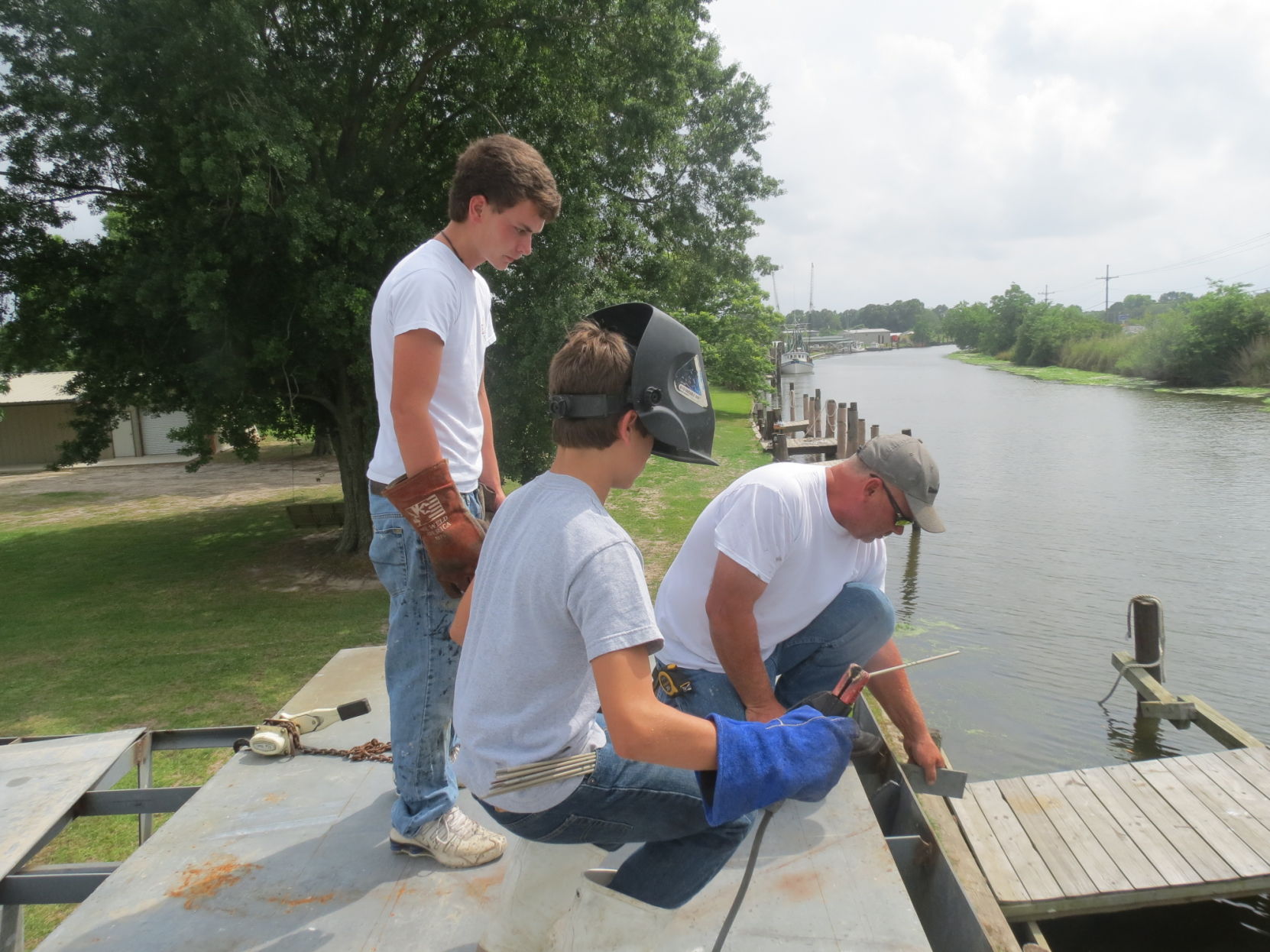BREAKING: Child drowned in Terrebonne
May 17, 2015
Jingles is more than just a pet
May 20, 2015A time-honored tradition among Bayou Region families – the building of fishing vessels in the yards of their homes, in many cases involving multiple generations – could soon be a thing of the past.
The front- and backyard vessels, which in recent decades have included 70- and 80-foot steel-hulled shrimp boats, once made financial sense. But local shrimpers say increased costs and in particular huge changes on the regulatory horizon are making what was once a viable alternative too costly.
Chad Portier of Chauvin is in the process of building just such a vessel, 72 feet in length if measured by the keel, to be called “Jesus Lives.”
Chad learned to build boats from his father, Russell. He is teaching his sons, Chad Jr. and Jenson Engebretson, how to build with him.
“That’s really why I am doing it,” the veteran shrimper said. “There’s not too many chances left for them to build a boat. This can give them an idea how to put it together.”
Two recent changes in law – the Coast Guard Authorization Act of 2010 and the Coast Guard and Maritime Transportation Act of 2012 – contain new standards for newly built commercial fishing vessels.
“After July 1, 2013, if a vessel 50 feet or more overall in length was, or is, built it must meet survey and classification requirements,” reads a synopsis of the rules, provided by a Coast Guard official, Jonathan Wendland, following questions about the rules.
The law states that vessels operating beyond three nautical miles must be “designed, constructed, and maintained to the standards of a recognized classification society … shall remain subject to the requirements of a classification society and have on board a certificate from that society.”
Classification societies are internationally recognized organizations that provide various certifications for vessels flagged in their native lands.
Fishermen say the requirements could add $100,000 or more to the cost of a vessel’s construction. Among the requirements is that a surveyor or engineer sign off on construction of larger vessels.
Interviews and research of Coast Guard documents show that lesser requirements are in place for smaller vessels; A program is in place to allow some flexibility overall in requirements for fishing vessel safety, that may keep costs in the relatively tame waters of the Gulf from having to reach those spent in the fisheries of Alaska and other states where huge swells and voyages at great length from shore are more the norm.
Some of the most stringent requirements won’t take effect until 2016 or 2017; the vessel safety program is in some ways still a congressional work in progress.
Local fishermen acknowledge that safety is important, and they understand why the rules are in place. But they nonetheless question in regard to vessel construction what they see as a one-size-fits-all approach.
David Chauvin, a neighbor and in-law of Portier’s, recalls fondly the work he did with his father, Anthony Chauvin of Houma, constructing the 73-foot trawler Mariah Jade 20 years ago. The home-building made a big difference in cost, although bargains once common for materials are now scarce.
“Back then we figured how we could barter for materials with this guy or that guy and have a good deal,” David Chauvin said. “But those good deals nowadays are gone. We would build a boat out of old tank-iron, after we had sandblasted it and coated it with cement. Back then it wasn’t worth anything. It was eleven cents per pound.”
But the financial aspect of building the boats is the least of local shrimpers’ concerns. It is the cultural and familial aspect, the handing down of a skill through generations, that they say is what they fear losing most. Keen observers of local history and culture are saddened at the prospect. It was the fishing boats that were home-made, notes Thibodaux attorney and author Woody Falgoust, whose book “The Rise of the Cajun Mariners: The Race For Big Oil” chronicles how back-yard-built fishing boat exercises turned into backyard building of tugs and other oilfield service vessels in many cases.
“Definitely without a doubt they started with seafood vessels period, and it evolved as the needs evolved,” Falgoust said of the local workboat industry.
“It makes me sick,” he said, when informed of regulations blamed for the home-built fishing boat’s sunset.
“The boats work fine, why do you need a regulation that does this? There isn’t any data out there. The problem is there has been a lot of over-regulating over the years. Obviously some regulations have helped the industry. A lot of safety regulations are pretty food. But I don’t understand why they need to re-invent the wheel, particularly if what you end up with is not a better mousetrap. These boats worked well for decades, they caught fish and caught shrimp and caught crabs. Why would you force them to change the way they build them? Why would you when there isn’t any data out there to support that?”
Falgoust’s book contains several references to pioneers of the offshore marine sector who built vessels with minimal written plans on scraps of napkins, or who directed construction of a vessel from a tree on their property, for a better view of how components would work together, or what measurements should be altered.
“Nolte Theriot, he would sketch the tug, a sketch of just seven bulkheads for an anchor-handling tug. He would draw each on a separate sheet, bring the sheets of paper to the shipyard and then he put the measurements on there.”
Theriot’s vessels ended up working the North Sea.
Anthony Chauvin’s memories of building the Mariah Jade – then called “Lady Kimberly” – with son David. And he regrets that he will likely not be building boats with his grandsons, or they with their own sons.
“It will cost so much more money,” Anthony Chauvin said. “The blueprints, the way they talk about laying a keel. I didn’t build with blueprints. I built the way I wanted, built just as I saw it. We built boats out of our heads. We built the plumbing, the electricity, lining it all up.”
Anthony Chauvin remembers the process well.
“I would build in the front yard, one sheet of steel at a time,” he said. “You’ve got to frame it up, lay the keep down first and then the bulkheads and then you get the shape of your boat. You would come up two foot to a V at the bottom and then you flared out your top sheet. The belly has to have a little flare. To keep it held up you put a rope out there, and then you rib everything to it and it falls into place. What is bad is that with these changes, all that will be lost.”
From left: Jenson Engebretson and Chad Portier Jr. with their father, Chad Sr. on the temporary deck of the trawler Jesus Lives, which they are building at their Chauvin home. The family has a long tradition of building their own vessels.













